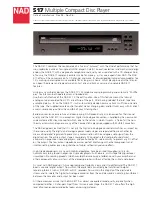
Chapter 6. Sound Settings
56
Karaoke.
Removes all sound that is common to both channels. Since most music is
recorded with vocals being equally present in both channels to make the singer
sound centrally placed, this often (but not always) has the effect of removing the
voice track from a song. This setting also very often has other undesirable effects
on the sound.
6.7. Stereo Width
Stereo width allows you to manually specify the effect that is applied when the
Chan-
nels
setting is set to “custom”. All values below 100% will progressively mix the contents
of one channel into the other. This has the effect of gradually centering the stereo im-
age, until you have monophonic sound at 0%. Values above 100% will progressively
remove components in one channel that is also present in the other. This has the effect
of widening the stereo field. A value of 100% will leave the stereo field unaltered.
6.8. 3D Enhancement
3D Enhancement increases the perceived separation between the left and right channels.
It works by subtracting a portion of the opposite channel’s content for each channel.
This setting controls the amount of opposite channel content that is subtracted. A value
of 0dB leaves the audio signal unmodified.
6.9. Crossfeed
Crossfeed attempts to make the experience of listening to music on headphones more
similar to listening to music with stereo speakers. When you listen to music through
speakers, each ear will hear sound originating from both speakers. However, the sound
from the left speaker reaches your right ear slightly later than it does your left ear, and
vice versa.
The human ear and brain together are very good at interpreting the time differences
between direct sounds and reflected sounds and using that information to identify the
direction that the sound is coming from. On the other hand, when listening to head-
phones, each ear hears only the stereo channel corresponding to it. The left ear hears
only the left channel and the right ear hears only the right channel. The result is that
sound from headphones does not provide the same spatial cues to your ear and brain as
speakers, and might for that reason sound unnatural to some listeners.
The crossfeed function uses an algorithm to feed a delayed and filtered portion of the
signal from the right channel into the left channel and vice versa in order to simulate the
spatial cues that the ear and brain receive when listening to a set of loudspeakers placed
in front of the listener. The result is a more natural stereo image that can be especially
appreciated in older rock and jazz records, where one instrument is often hard-panned
The Rockbox manual
(version 3.14)
Sansa Fuze+
















































